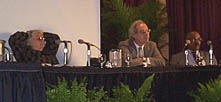|
WHERE
IT BEGAN
First
panel tackles 'Origins of the Slaves'
By
Christopher Dale
Historian Colin
Palmer reported that nearly two-thirds of all Africans who came
to North America in the slave trade originated from 300- to 400-mile
swath of west-central Africa, and his mostly African-American audience
let out a collective gasp.
This appeared
to be less because of the significance to African history of this
relatively recent finding, and more because of what it meant for
their own.
As the soft-yet-surprised
calls of "How about that?" and "Oh my" died down and the crowd settled
in again, Palmer vindicated the expressions of surprise.
|

(left to right) Gwendolyn Midlo Hall, Paul E. Lovejoy and
Colin Palmer.
|
"These statistics
have enormous implications for our understanding of the ethnic and
cultural stream that contributed to the making of the African-American
peoples," he said. A professor of history at CUNY, Palmer has written
several books on Africa, including Passageways:
An Interpretive History of Black America, his most recent
work.
The panel, entitled
"Origins of the Slaves," took place Oct. 5 at NYU Law School's Tishman
Auditorium. It was the first of more than a dozen scheduled symposia
and presentations in the week-long "Slave Routes: The Long Memory,"
an international conference sponsored by the university's Institute
of African-American Affairs and the Africana Studies Program.
|

Six
major regions of the African slave trade
|
For this first
panel, Palmer joined three other keynote speakers to discuss results
of current research about the origins of African slaves during the
slave trade -- the largest forced migration in the history of mankind
involving some 11 to 13 million people over a span of 350
years.
His fellow
panelists were Paul E. Lovejoy, a professor at Canada's York University
and author of such books as The Ideology of
Slavery in Africa; Djibril Tamsir Niane of Ghana, a member
of the Societe Africane D'Edition, who spoke through an interpreter;
and Gwendolyn Midlo Hall, a Gugenheim scholar who taught history
at Rutgers University for twenty-five years.
Palmer
also took advantage of the occasion to introduce other new data
on the slave trade to the general public, such as evidence concerning
the African regions that produced
the majority of the world's slaves. Palmer said that the number
of slaves who ended up in the United States, for example, represents
only about 6 percent of the total number of Africans forced into
slavery. Further, he said, that nearly 80 percent of all enslaved
Africans came from an area extending from Sierra Leone to Angola,
a coastline of approximately 2,700 miles.
|

![]()
![]()